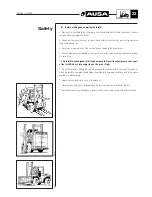
30
CH 200 / CH 250
(fig. 2)
(fig. 1)
(fig. 4)
(fig. 3)
Periodic
Maintenance
Operations
General Maintenance Recommendations
- Forklift efficiency and safety of operation requires proper and regular maintenance. Only quali-
fied mechanics with proper tools should perform maintenance operations and any necessary
repairs to the machine.
- Unless work on the engine demands that it be running, all repairs and maintenance on the
machine should be done with the machine parked, engine stopped, forks down and unloaded,
and wheels blocked to keep the forklift from moving during servicing.
- Disconnect the battery loosing the terminal (-)before carrying out any maintenance or repairs to
the electrical system. Check that the charging warning light works properly before charging the
battery. This is done as follows: With the engine off, turn the key switch counter clockwise and
the instrument panel "battery charge" lamp will light. When the engine starts however this battery
charge lamp will go out indicating that the battery is being properly charged by the alternator.
Disconnect the alternator when using a fast battery charger or when performing welding on the
chassis of the forklift. The alternator should only be run when the battery and the voltage regula-
tor are connected to the electrical system. To run the engine without the battery, disconnect the
alternator belt.
- The hydraulic system should be checked periodically to avoid poor performance or accidents,
which might be caused by hydraulic oil leaks or by maladjustment of the pressure relief valves.
Take precautions to avoid spilling before disconnecting any of the fluid system circuits. Never use
an open flame to check fluid leaks or levels.
- Only use OEM (Original Equipment Manufacturer) parts obtained from your AUSA dea-
ler. Be certain to use the right type and size of tires. Never use split rims, (rims that are
formed by 2 halves which are screwed together).
Access for maintenance
The engine, the transmission and filters are located under the cabin floor (fig.1). To access them,
you have to procede as following:
- With the operator at the operator seat, start the machine and tilt the mast fully forwards.
- Open the glove compartment located under the arm rest at the right of the operator seat.
- Pull the control located at the back side of this compartment (fig.2) to unblock the latch of the
cabin, then lift and tilt it forward.
- Insert the safety prop in the position shown in the pictures 3 and 4.
-CAB SAFETY PROP STOWED AWAY(Fig.3)
-CAB SAFETY PROP LOWERED INTO POSITION (Fig.4)
Summary of Contents for CH 200
Page 1: ...CH 200 CH 200 x4 CH 250 CH 250 x4 OPERATOR S MANUAL ENGLISH ...
Page 2: ...AUSA Forklift CH 200 CH 200 4x4 CH 250 CH 250 4x4 ...
Page 3: ......
Page 11: ...11 CH 200 CH 250 Machine decals USA market Information ...
Page 12: ...12 CH 200 CH 250 Machine decals USA market Warning Load charts ...
Page 13: ...13 CH 200 CH 250 Machine decals UK market Information ...
Page 14: ...14 CH 200 CH 250 Load graphs Machine decals UK market ...
Page 37: ...37 CH 200 CH 250 Electric circuit CH200 1 ...
Page 38: ...Electric circuit CH200 2 38 CH 200 CH 250 ...
Page 39: ...Electric circuit CH200 3 39 CH 200 CH 250 ...
Page 40: ...Electric circuit CH200 4 40 CH 200 CH 250 ...
Page 42: ...Electric circuit CH250 1 42 CH 200 CH 250 ...
Page 43: ...Electric circuit CH250 2 43 CH 200 CH 250 ...
Page 44: ...Electric circuit CH250 3 44 CH 200 CH 250 ...
Page 45: ...Electric circuit CH250 4 45 CH 200 CH 250 ...
Page 47: ...Hydraulic diagram Side shift 1 47 CH 200 CH 250 ...
Page 48: ...Hydraulic diagram Hydromatik CH200 1 48 CH 200 CH 250 ...
Page 49: ...Hydraulic diagram Hydromatik CH250 1 49 CH 200 CH 250 ...
Page 51: ......





































